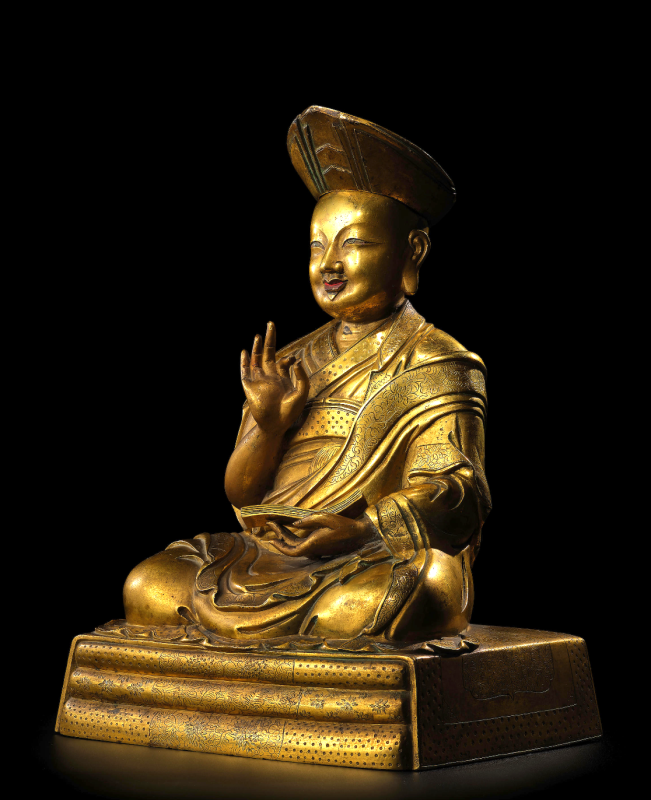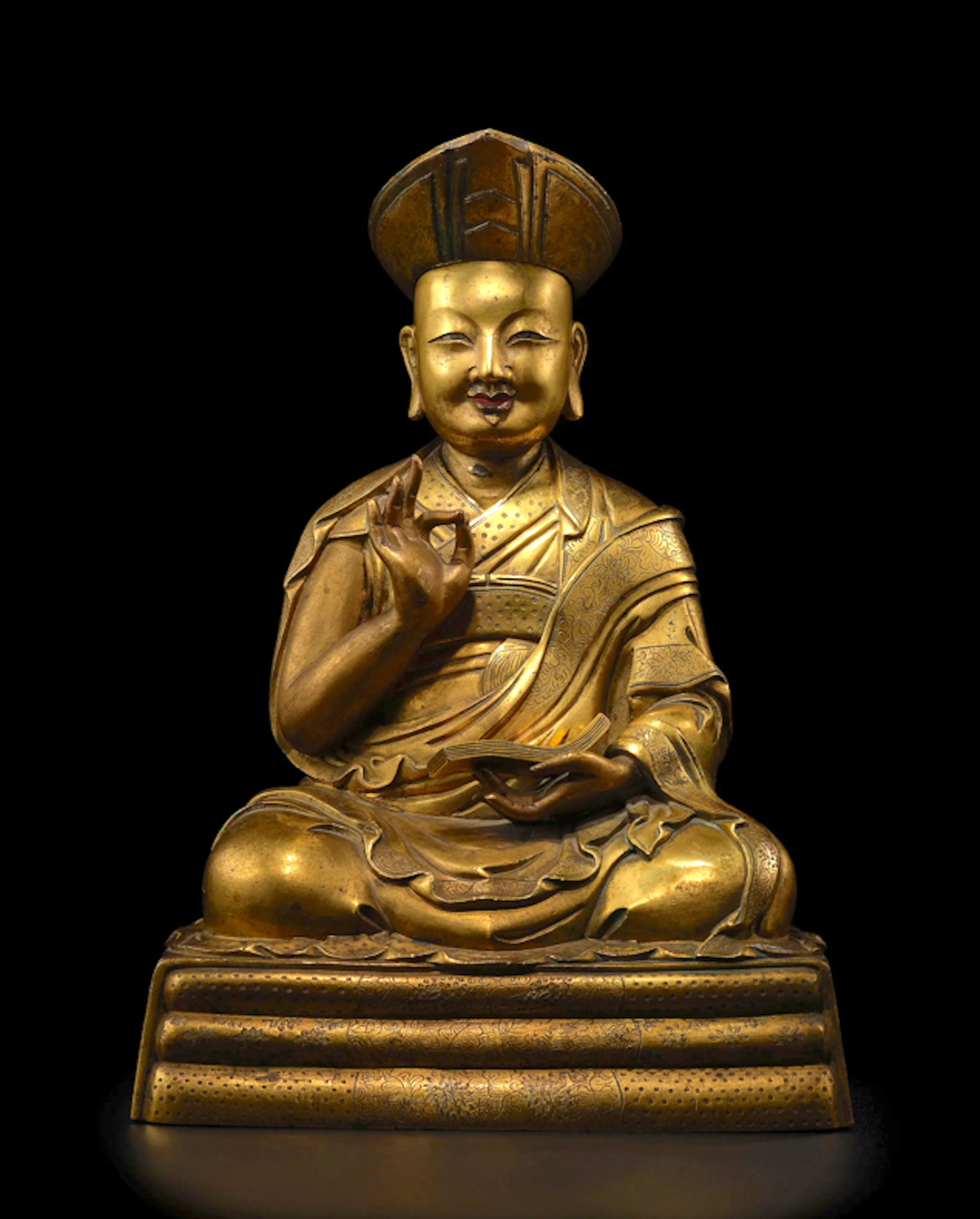
Provenance:
Swiss Private Collection, acquired in the 1920s
Schuyler Auction, Zurich, December 15, 2016, no. 1037
Michael Henss Collection, Zurich
Published:
Michael Henss, "The Changkya Huthugthu Rölpai Dorje–Grand Lama of China, Buddhist Teacher of the Empire, Imperial Art Consultant, 1717–1786: An exquisite image in the Zhiguan Museum, Beijing," in Asianart.com, November 2020, figs. 9 & 10
Depicted in this large cast sculpture is Rolpai Dorje (1717-86), the principal authority of Tibetan Buddhism at the Chinese court for half a century during the reign of the Qianlong Emperor. This was a period when no less than 959 Tibetan and Mongolian monks stayed in the Qing capital of Beijing in 1736. He was also known by his Mongolian hereditary title of Changkya Huthugthu, "His Holiness" or "The Great Blessed One," a most meaningful epithet for an eminent religious authority in the Qing dynasty milieu.
Having been recognized at an early age as the reincarnation of the First Changkya Huthugthu, Ngawang Losang Chöden (1642-1714, the spiritual mentor of the Kangxi and Yongzheng Emperors), Rolpai Dorje entered the nearby Gonlung monastery (Temple of the Protecting Peace) at the age of three; he was the Abbot until 1769.
In 1724, Rolpai Dorje as the young "spiritual master" was brought to his monastic residence, Songzhu temple. It was here where he was educated in the essential culture and politics of the court for his later diplomatic career between Beijing and Lhasa. Rolpai Dorje soon learned to speak and write Chinese, Mongolian, and Manchu fluently. Under the guidance of great Gelugpa teachers like the Thukwan Huthugthu, he studied the Kanjur canon together with Hongli, the crown prince who would later become the Qianlong Emperor (b. 1711).
In 1734, Rolpai Dorje was appointed National Preceptor by Prince Hongli's father and predecessor, the Yongzheng Emperor (1723-35), who bestowed the rank of 'Teacher of the Empire' upon him. During the same year, he made his first visit to Tibet, where he received his monastic vows and the final ordination as a geshe from the Second Panchen Lama Losang Yeshe (1663-1737) at Tashilhunpo monastery in 1735. It was in early 1736, on his return to Beijing from Lhasa, that his former classmate Hongli was coronated as the Qianlong Emperor. In turn, Rolpai Dorje was appointed "Lama of the Seal," the highest rank of a Tibetan Buddhist monk in China. This was equivalent to the position of the Thukwan Huthugthu, his former teacher at the court. With the exception of the Third Panchen Lama (1738-80), no other Buddhist monk in the Qing dynasty was as much honored as Lalita Vajra, "the Playful Vajra," the Sanskrit epithet name for this Grand Lama of the Empire.
With the transformation of the princely palace Yonghegong into a Buddhist temple in 1744, the Beijing center of Tibetan Buddhism to this day, Rolpai Dorje started various undertakings in art and architecture in the Qing capital. He became the supervisor of all Buddhist temples. A Buddhist academy with four colleges and 500 monks was established, and a catalogue of Buddhist statues and paintings in the Palace collection was compiled. In 1745, he initiated the emperor into the Chakrasamvara tantra, to which Qianlong said to his Tibetan guru after the ritual, "Now you are not only my lama, you are my vajra-master!" In a philosophical treatise in 1746, Rolpai Dorje reestablished the concept of the universal ruler, whereby the emperor is believed to be an emanation of Manjushri, the bodhisattva of Perfected Wisdom. For the legitimation of the worldly sovereign, he compares his tantric rites with those of the Sakya lama Phagspa (1235-80). Phagspa, who was regarded as one of Rolpai Dorje's previous incarnations, initiated Khubilai Khan (1215-94), the founding emperor of the Yuan dynasty and also a manifestation of Manjushri through the Hevajra Tantra. This directly links the priest-patron relationship between Phagspa and Khubilai Khan with that of Rolpai Dorje and the Qianlong Emperor.
As with representations of the Dalai and Panchen Lamas, there is not a single fixed iconographic program for the various images of Rolpai Dorje. With the exception of the vajra and ghanta, only the gesture of argumentation (vitarka mudra) is a common feature for all. Including some identified paintings of Rolpai Dorje, his most common iconography is him as a teacher displaying the gesture of argumentation. His proper left hand, when not displaying the hand in meditation, is either holding a longevity vase filled with the elixir of immortality as an emanation of Manjushri, or a Tibetan poti book, as depicted here.
As a monk-teacher, Rolpai Dorje is shown either bald or as he is represented here, wearing the prominent folded "Huthugthu hat." The folding hat exists in various forms and was also cast separately for larger statues like this one and one in the Zhiguan Museum of Fine Art, Beijing, which is nearly of the same scale and weight as the one here. In both images, the eyes and mouths, as well as the lotus attributes, are polychromed. The different facial features between these two images appear to represent individual personalities, and both are impressively rendered with a portrait-like quality beyond the generic depictions of lamas. Impressive for is considerable weight and size, the personalized features of this sculpture testify to its importance as an imperially-commissioned work.

